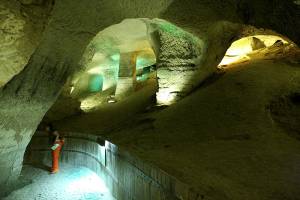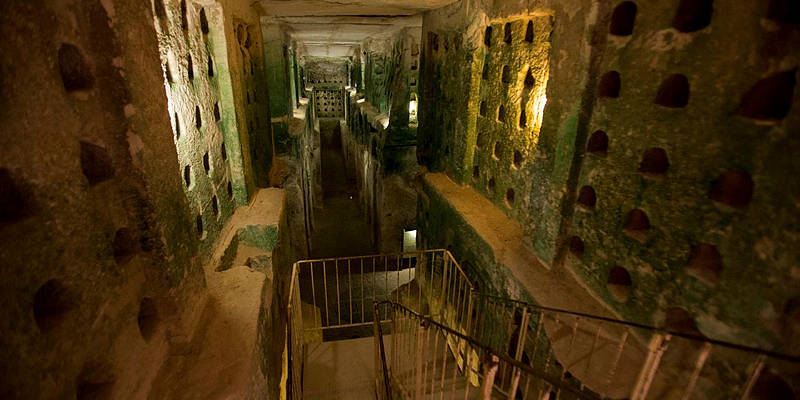

The Beit Guvrin cave network and archaeological site in the Judean Lowlands is eighth on the list of UNESCO World Heritage Sites.
The United Nation’s Education, Scientific, and Culture Organization (UNESCO) declared the Beit Guvrin-Maresha National Park in the Judean Lowlands as a World Heritage site, joining seven other sites in Israel that hold this distinctive and prestigious certification.
The declaration was made in June 2014, but the official ceremony and certification took place at the site last Tuesday in the presence of representatives from UNESCO, INPA and other relevant bodies.
Calling Beit Guvrin a “microcosm of the land of the caves,” UNESCO noted that the site, “situated on the crossroads of trade routes to Mesopotamia and Egypt, bears witness to the region’s tapestry of cultures and their evolution over more than 2,000 years.”
The archaeological site, known for its unique bell caves, is scattered over an area of about 100 square kilometers. It contains some 3,500 underground chambers distributed among distinct complexes carved in the thick, homogenous soft chalk of the region. The quarried caves served as cisterns, oil presses, baths, dovecotes, stables, places of religious worship, hideaways and burial areas.
‘An Outstanding Site of Global Value’
Dr. Zvika Tsuk, chief archaeologist of Israel’s Nature and Parks Authority, stated in June, when the declaration was made: “Thanks to the large number of caves and their various types, as well as the duration for which they were used, spanning nearly 2,000 years, this special site has won recognition as an outstanding site of global value.”
The ancient town of Maresha and Beit Guvrin are two main sites in a larger area of caves and hiding that existed just off the Via Maris route during the Byzantine period. According to evidence produced by Prof. Yoram Zafrir, one of Israel’s veteran archaeologists, over 100,000 people lived in this area away from the main trade route. The main urban settlements in the Judean foothills were safely removed from the main Via Maris with its movements of conquering armies between Egypt and the Fertile Crescent.

Part of the cave network. (Moshe Shai/Flash90)
Maresha and Beit Guvrin, important ancient cities located in the basin of the Guvrin Stream, were highly populated in the Greco-Roman and Byzantine eras, and their unique natural formations were used as hiding places for the local population in conjunction with tels and neighboring towns. Maresha is mentioned among the cities of Judea noted in the Book of Joshua and as one of the cities fortified by Kinig Rehoboam against the incursion of Babylon into his kingdom: “And Rehoboam… built cities for defense in Judah. He built even Bethlehem…and Mareshah.”
Today the caves, located south of Beit Shemesh and east of Kiryat Gat, host tourists and visitors from all around the world and serve as a setting for several musical and cultural events throughout the year.
The other Israeli sites on the list are: Masada; the Old City of Acre; the White City of Tel Aviv; the biblical tels of Megiddo, Hatzor and Beersheba; the incense route of desert cities in the Negev; and the Baha’i holy places in Haifa and the Western Galilee.
By: United with Israel Staff

Free Ebook: 10 Best Places to Visit in Israel
The Land of Israel has provided the backdrop for some of the most important events in human history. From the Old City in Jerusalem to the Sea of Galilee, people from all over the globe visit the Holy Land each year to take in the breathtaking scenery and inspiration of Israel. Now you can experience this beauty for yourself from the comforts of home and maybe plan a trip of your own to Israel. Get the free, exclusive eBook from United with Israel: The 10 Best Places to Visit in Israel.
Send Passover Packages to Needy Israeli Soldiers - Bring Them Joy!
We are honored to thank the young men and women of the IDF who risk their lives every day to protect the citizens of Israel. Since October 7th, soldiers have been on the battlefield for months - many are hoping to come home for Passover.
Join us in sending Passover food packages (and personal notes) to Israeli soldiers and their families.
Many soldiers spend the Passover holiday with needy families back home. The soldiers greatly appreciate your love and concern. Bring them Passover joy!
CLICK HERE TO SEND YOUR PACKAGE AND NOTE TO ISRAELI SOLDIERS!




